December 2009 Vol. 64 No. 12
Features
High Performance Fabric In Old Piping: Quick, Durable Restoration Of Operational Safety

During the World Gas Conference in Copenhagen, Denmark in June 1997, representatives of U.S. gas utilities asked members of Karl Weiss Technologies, Berlin, Germany, whether they could develop a special fabric hose rehabilitation system for gas services featuring 90 decree elbows.
Karl Weiss agreed to start development work.
In 1998, successful demonstrations convinced gas utilities of the professional performance and efficiency of the technology. On Feb. 10, 1999, Karl Weiss established Starline Trenchless Technology, LLC to promote and commercialize trenchless technologies in the U.S. The Gas Research Institute (precursor to today’s Gas Technology Institute) joined the newly formed company as a strategic partner.
Subsequent development of the technology has diversified the applications of starline technology into pressure water pipe as well. Now, aging gas and water mains are returned to their original strength through the use of flexible, seamless, circular-woven fabric liners installed in the pipes with a special inversion process, without the need for long trenches. This relining process, unlike open-trench gas and water-line replacement, enables utilities to minimize traffic control, excavation, and pavement and landscape restoration – tasks that can account for up to 70 percent of the cost of gas and water-line rehabilitation. Unlike straight or rigid liners, cured-in-place liners can be installed through bends, fully open fittings and where there may be variations in internal pipe diameters.
Case study
In Germany’s capital city Berlin, drinking water is distributed through a 4,900-mile-long pipe network and pumped to 262,000 house connections, 62,000 hydrants and 90,000 valves. Nevertheless, even during consequential maintenance, damage to pipes cannot be totally prevented. When repairing damage to pipes, Berlin Water Works can implement individually suited solutions as was the case recently with the quick and durable restoration of a 20-inch cast iron drinking water pipe by means of woven fabric liner.
In Berlin, just two to 3 percent of recorded water losses occur through distribution of drinking water. This very low figure, by national and international standards, is a result of systematic maintenance and upkeep of the pipes and fittings. For example, it is in this way that one percent of the pipe network will be repaired each year. Likewise, the number of damages to mains and supply pipelines has continually decreased as a result of these measures. Currently, the rate of pipe damage is less than 0.11 pipe damages per mile, per year. This is a comparatively low value even in relation to the appropriate standard. Nevertheless, pipe damages cannot be prevented even through consequential maintenance. However, the following report shows that Berlin Water Works does not just repair pipe damage. On the contrary, depending on the damaging event and condition of the pipe, the most appropriate methods will be selected so that the necessary operational safety and hygiene of the affected section of piping can be restored.
For this project, expectations were met when Starline HPL-W woven fabric relining was used to rehabilitate a 20-inch cast-iron drinking water pipe. Apart from the fulfilling hygienic requirements, the provisions for design in DVGW worksheet GW 327 were adhered to. For this reason, the prerequisites for a permanent rehabilitation of necessary operational safety are given. Savings on underground work have led to an expected reduction of building time and significant reduction of costs. Only approximately 50-60 percent of the costs that would have been incurred from an exchange in open construction have materialized through use of the woven fabric liner.
Fig. 1 (1) Outlet of a crusted and decrepit local drinking water pipes.
(2) Grey cast-iron cleaned by sandblasting.
(3) Reversion of the adhesive filled woven fabric liner.
(4) Long-term, crease-free and burst-proof lined pipe.
Chronology of pipe damage, repair strategy
Feb. 10: When two teams playing football noticed the grass around a penalty spot was starting to get moist and wet, Berlin Water Work’s fault-clearing service was called out. They immediately ascertain that there was pipe damage to a grey cast iron 20-inch (DN 500) drinking water main. The 1,706-foot section of piping affected runs alongside a school and continues under four sports fields. The pipeline was constructed in 1926 and transports drinking water from a water works facility in the eastern region of the city to the inner city.
Feb. 11: A team of experts gathered in Berlin’s district Mitte, at the relevant Berliner Water Works pipe network operating facilities from the domain of pipe work damage. This is one of five operating facilities in Berlin. Appropriate measures for long-term removal of pipe work damage are discussed. The general conditions are made clear during the course of the meeting:
- The pipe network database shows that the pipe has already been damaged on several occasions and therefore a high probability of failure exists;
- The pipe is situated underneath three newly constructed sports fields and a school yard;
- The pipe network calculation experts determine that the cross-section must remain; and
- Due to dependency on other building work and the impending summer time, a brief removal from service is possible for only a few weeks.
As a result of the discussion it was decided that the condition of the pipe would be determined by a test shafting and pipe cuttings.
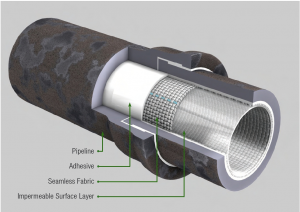
Fig. 2
Lining of the pipe inner wall through holohedral and exfiltration sealed bonding with a smooth, circularly woven fabric liner made from high-strength and non-ageing fibers.
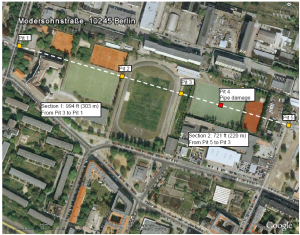
Fig. 3
Layout of pits and sections of the piping with a length of 994 feet in section 1 and 721 feet in section 2.
Decisions
Two weeks later: Operations for the production of two pits are severely hindered by retained water and because of weather conditions. From interim research of the plan archive, it emerges that the pipe suffered bomb damage in 1944 and was replaced with steel in several areas. Furthermore, the material tests on the pipe cuttings show that in essence, the grey cast-iron material has a residual wall thickness of 11/16 inches. For the areas with steel piping, it must be assumed that it is highly corroded because of corrosion protection applied at that time (use of bitumen or tar). Deposits and incrustations from the pipe only exist on a low scale. As a result of the examined pipe cuttings, the pipe is classified as being able to be restored.
In consideration of all general conditions and with respect to the available financial means, it is suggested that the pipe be restored with woven fabric relining. In this process, a woven fabric liner coated in plastic is soaked at first. Reversion by means of compressed air then takes place within the pipe being restored. At the same time, the wetted adhesive side of the woven fabric liner is upside down and holohedrally stuck on to the inside of the pipe that was cleaned earlier (Fig 1 + 2). Reliable connections or outlets will be opened from the inside in advance by robots. As a result, heavy costs for underground work will be kept to a minimum. New connections can be connected without problems and sealed against exfiltration in a conventional manner.
Existing and future occurrences of corrosion which represent a potentially enormous hygiene and technical safety risk in conveyor pipelines can be efficiently, quickly and sustainably repaired. Thereby, the required safety standard is permanently restored and additionally, a minimization in the risk of weld seam breaks is achieved. Woven fabric relining enables the target state of the available pipe to be restored. This is achieved with the following features:
- Sealing of all present and future leaks therefore increasing or restoring necessary operational safety;
- Restoration of necessary hygiene;
- Precautionary corrosion protection against inner corrosion;
- Retaining the dimension of the available pipe and prevention of future incrustations;
- Preventive sealing of vulnerable weld seams;
- Application on places that are difficult to reach, on crossings, in ecologically sensitive areas, on stony grounds etc.;
- Reduction of problems with access rights and reduction of work in confined cramped conditions; and
- Economy through sustainability because woven fabric relining is classed as being a depreciable service due to a material life span of at least 50 years.
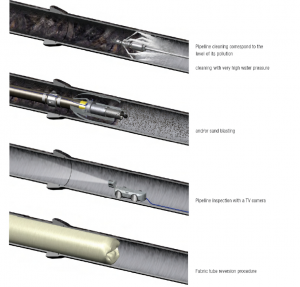
Fig. 4
Usual procedural steps for the woven fabric relining
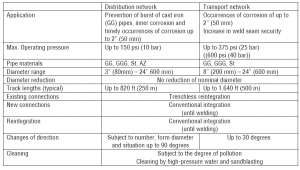
Table 1 Usual operational areas of woven fabric relining for drinking water pipes
As with all trenchless methods, the advantages of woven fabric relining can only be used if systematic quality assurance is in place. This must take into account the suitability of materials used with regard to hygiene, durability and mechanical features as well as their usage, i.e. implementation at the construction site. Furthermore, trenchless operations must be carried out with the same general knowledge and same quality as classic pipe construction. This is achieved through a controlled and documented procedure, qualified and trained staff and state-of-the-art equipment. In the DVGW worksheets for trenchless construction, there is a set of regulations in which requests specific to the operation, quality assurance on the construction site and necessary tests are defined. Using this set of regulations it can be ensured that upon intended use, the quality of a pipe constructed using classic construction techniques.
The absolutely necessary prerequisite for the choice of procedure was the present proof of harmlessness in hygienic drinking water with regard to physiology and microbiology. For this reason, requirements according to DVGW worksheet W 270, the epoxy resin guideline as well as the KTW guideline and KTW recommendation of Germany’s Federal Authority of Health were to be fulfilled. It must be ensured that the coated woven fabric liner joined with the adhesive (i.e. stuck to the pipe), fulfils the hygienic and microbiological requirements for pipes in the corresponding diameter category. A further obligatory prerequisite for the rehabilitation of the approximately 1,706-foot-long pipe section was the allowance for the yet to be published GW 327 worksheet “Lining of gas and water pipes with pasted woven fabric liners” which was worked on as a part of the DVGW project entitled Trenchless Construction.
This DVGW worksheet shows the revision and extension to the standard approved DVGW G 478 worksheet concerning the water application area. It determines requirements, quality assurance and tests for procedural practice in line with quality. Likewise, the requirements for the material used, i.e. woven fabric liner as well as its combination with the pipe wall, are determined in the DVGW worksheet W 330 entitled Pasted woven fabric liner for water pipes. According to this state-of-the-art, woven fabric relining is regarded as a burst-proof rehabilitation procedure. The existing pipe will be lined holohedrally and sealed against exfiltration with a non-aging woven fabric liner. Corresponding to DVGW test basis VP 404, it is proven through 10,000 hours of creep testing that a bridging of corrosion damage in pipe diameters of up to 2-inch has a life span of at least 50 years. An overview of the possible fields of application for woven fabric relining based on the aforementioned DVGW worksheets is provided in table 1.

Fig. 5
Small pit for high-pressure water cleaning with mobile hose reel and rotating nozzle with 22,500 psi (1,500 bar) (View from pit 2 towards pit 3)
Fig. 6
See article header.
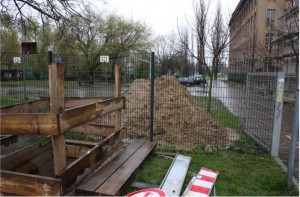
Fig. 7
Small target pit of section one.
Procedural application, recommissioning
March 21: Due to the local conditions and existing fittings, a total of five pits were dug and two sections for the woven fabric liner reversion with lengths of 721 feet and 994 feet respectively were designated (Fig. 3). Therefore, the layout of the pits was in such a way that apart from the pit in the area of the burst pipe, no further sports fields were taken up or spoiled by cleaning and inspection equipment. All prepared work has finished. The inner cleaning (Fig. 4) of the pipe is followed by high-pressure water cleaning (Fig. 5) and subsequent partial sandblasting.
The result was checked and documented by camera inspection. The diameter of the woven fabric liner to be constructed and the necessary reversion pressure were determined by bore-measuring. An economic implementation was achieved through use of a special inspection and bore-measuring system for tracks lengths of up to a maximum of 3,000 feet.
March 24: Reversion of the woven fabric liner takes place in section one. Overall, for the track length of 994 feet, over 2,200 pounds of adhesive are mixed in and filled into the woven fabric liner. The reversion of pit three takes place towards pit one. In this instance, the self-propelled and thus mobile pressure drum proves to be particularly advantageous because an exact positioning in the pit can take place on a platform area. Despite the large working weight of approximately 31,000 pounds, no damage to the surface fastening occurs due to the rubber-reinforced caterpillar chassis. As the diameter of the woven fabric liner is designed for placement within the inner diameter of the pipe to be rehabilitated, a long-term, crease-free liner is achieved despite the high-strength woven fabric. Through the cold, hardening adhesive system with a very long pot life, the thermally induced tensions in the existing pipe which can occur during warm hardening and cause weld seam breaks in bitumen-coated pipes, will be closed. After hardening of the adhesive, the woven fabric liner is holohedrally and permanently stuck to the inner wall of the old existing piping.
March 25: The woven fabric liner reversion of the 721-foot-long section two is being carried out. For this purpose, 1,764 pounds of adhesive is used. Reversion takes place from pit five (Fig. 8 + 9) to pit three.
The pipe is positioned after the carrying out of the pressure test and trenchless opening of hydrant connections in section one with the aid of tiller robots. Once the water test corresponds to the drinking water ordinance.
May 14: The works are completely finished. During construction time, the existing sports fields were able to be used apart from the actual area of pipe damage.
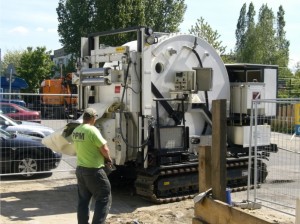
Fig. 8
Positioning of the self-propelled pressure drum with rubber-reinforced caterpillar chassis at the starting pit (pit five)

Fig. 9
Pressure drum during hose reversion at the starting pit (pit five) of section two.

Table 2 List of DVGW rules for trenchless constructions
Summary
Woven fabric relining is carried out with the aim of preserving the existing pipe. Upon the right selection and application with fluid engineering characteristics and technical grading, the pipes lined with woven fabric liner are close to being renewed to new pipes with the same dimensions. The advantage this has over a conventional exchange is particularly to do with a rapid construction and a saving of 90 percent on earthworks. Water pipes made out of grey cast iron, steel, reinforced concrete or asbestos cement are permanently lines with pressure-resistant, smoothly woven textile fabric liner. In future, burst pipes as well as local corrosion damage with a diameter of up to 2-inches will be permanently and securely bridged through the high-strength texture.
Expectations for rehabilitation of a grey cast-iron 20-inch water pipe, by means of Starline HPL-W woven fabric relining, were completely fulfilled. Apart from the fundamentally necessary fulfilling of hygienic requirements, the provisions for design in DVGW worksheet GW 327 were adhered to. For this reason, the prerequisites for a permanent rehabilitation of necessary operational safety are given. Savings on underground work have led to an expected reduction of building time and significant reduction in costs. Only approximately 50-60 percent of the costs that would have been incurred from an exchange in open construction have materialized through use of the woven fabric liner.
Furthermore, negative accompaniments entailed through conventional underground work, e.g. restriction of space, have been significantly reduced. Moreover, relevant environmental aspects have an ever increasing impact. Only the positive effect of the trenchless construction in relation to the associated reduction in CO2 emissions is referred to. A clear saving on carbon dioxide through the elimination of underground work and transport journeys for ground storage and change of grounds within the inner-city area is to be noted. In this case, only five pits with a total length of 53 feet have been constructed for the rehabilitation of a 1,716-foot long section of piping.
In comparison to open construction, the proportion of earthworks for woven fabric relining still only amounts to approximately three percent. This is equivalent to a possible direct saving of approximately 97 percent for CO2 emissions generated by ground transport carried out by a lorry. Depending on the constraints of this example, this may correspond to a reduction of up to 33,000 pounds of CO2. Overall, based on a comparative analysis, there is an approximately 260 percent higher CO2 rate with open construction. In absolute value, a saving of approximately 62,000 pounds CO2 can be estimated on this project alone.
For the woven fabric relining, it is a great example of a win-win situation. However, while woven fabric relining represented the best solution on this building site. Other procedures under different operating conditions offer rehabilitation possibilities that are equally effective. Over the past years, the “Trenchless Construction” work group at DVGW has developed the corresponding Technical Rules (table 2).
FOR MORE INFORMATION:
Starline Technologies (GTI): (847) 544-3428, www.starlinett.com




Comments